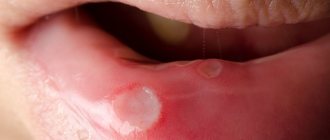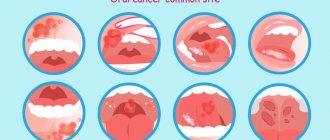Drugs
- Entrop
- Enterofuril
- Entoban
- Enterospasmil
- Enterosgel
- Enterolax
- Enterokind
- Enterol
- Enterogermina
- Enkorat
Alexey Portnov, medical editor Last edited: 06/24/2018
x
All iLive content is reviewed by medical experts to ensure it is as accurate and factual as possible.
We have strict sourcing guidelines and only link to reputable sites, academic research institutions and, where possible, proven medical studies. Please note that the numbers in parentheses ([1], [2], etc.) are clickable links to such studies.
If you believe that any of our content is inaccurate, out of date, or otherwise questionable, please select it and press Ctrl + Enter.
Stomatitis, not complicated by temperature or intoxication, especially in the initial stage, can be cured with the help of local applications with special gels. In this case, ointments are not so effective, since the fat base does not allow rapid absorption of the main medicinal components into the mucous membrane. The gel form is more effective, the gel is better absorbed and its active ingredients penetrate well into the source of inflammation, stopping it. Gel for stomatitis can be intended for anesthesia, but most often it also includes anti-inflammatory components, so this remedy rightfully belongs to the category of combined topical preparations. The gel is selected by the doctor according to the type of inflammation, its severity, and the location of aphthae (ulcers).
Let's consider the most effective gel forms of medications that help reduce the intensity of symptoms of stomatitis:
- Stomatitis caused by a virus often manifests itself not only in the oral cavity, but also on the lips. In such cases, external agents are prescribed in the form of ointments, and the internal cavity is treated with applications of an effective interferon gel - Viferon. The drug is applied to slightly dried inflamed areas, three times a day for a week. Viferon gel has an excellent effect on the inflammatory process, regardless of the patient’s age and has no contraindications.
- Bacterial stomatitis, antiseptic treatment of the oral cavity for any type of inflammation are well controlled by Elugel. Elugel is a chlorhexidine-based product that can be used as a medicine and also as a local prophylactic drug. A wide spectrum of bactericidal action allows Elugel to be used to neutralize almost all types of bacteria and fungi. The gel is applied to damaged areas of the oral cavity 3-4 times a day, the greatest effect is achieved if the patient carries out parallel rinsing with Eludil solution. Please note that Elugel must be absorbed into the mucous membrane and does not require rinsing; solutions are usually used 2-3 hours after applying the gel applications.
- The initial stages of stomatitis are well treated with Cholisal-gel, which helps to anesthetize the inflammation and begin to neutralize it. Before applying Cholisal, the mouth should be rinsed with Miramistin solution; the procedure should be repeated 4 times a day for 7-10 days. Cholisal will also help to numb the resulting ulcers; the pain subsides literally 2-3 minutes after applying the gel, which is absorbed into the deep layers of mucosal tissue.
- After relief of acute symptoms, it is necessary to help the regeneration of mucosal tissue. Actovegin-gel comes to the rescue, which activates the process of restoration and healing of the oral cavity.
- Kamistad gel, which contains lidocaine and chamomile extract, has a good anesthetic effect. Kamistad is used not only as an anesthetic, but also as an antibacterial agent. By providing a local anti-inflammatory effect on the mucous membrane, Kamistad gel is able to alleviate the symptoms of stomatitis within a week and activate the healing process of the wound surface. Since the gel contains a large percentage of lidocaine, the product is used only as directed by a doctor.
- Herpetic stomatitis can be treated locally with Viru-Merz-Serol gel, which effectively relieves itching, pain and burning in the oral mucosa. The course of applying the gel is 5 days and should be stopped after the first vesicular formations appear.
- Antiseptic gel "Instillagel" contains two effective components - lidocaine and chlorhexidine. Simultaneous analgesia and antibacterial action provide fairly rapid neutralization of uncomfortable symptoms.
- Metrogyl Denta contains metronidazole and chlorhexidine. This combination of antibiotic and antiseptic provides rapid relief of the first signs of inflammation in the oral cavity, however, unlike Cholisal, Metrogyl Denta is not able to overcome the mucous membrane and is not absorbed into the deep layers of tissue. This gel for stomatitis is prescribed as a surface antibacterial agent that works in the initial stage of the process.
- Mundizal gel effectively fights inflammation and relieves pain in the oral cavity. This remedy can be used to treat stomatitis in both adults and children. The gel is able to be quickly absorbed and affect the deep layers of mucosal tissue, while simultaneously attaching to the surface of the oral cavity. Choline salicylate has an anesthetic surface effect, and tsetalkonium chloride, which is part of Mundizal gel, has an antimicrobial effect.
- Kalgel can help treat stomatitis in young children, which is also used during teething as a local antimicrobial and analgesic. Cetylpyridinium chloride has an antiseptic effect, and lidocaine relieves pain symptoms, however, these components can cause an allergic reaction, so independent use of Calgel is undesirable.
[1], [2], [3], [4], [5], [6]
Types of stomatitis
Depending on the reasons that caused inflammation of the oral mucosa, the following types of stomatitis in adults are distinguished.
Infectious.
Inflammation can be caused by various pathogens that develop against a background of weakened immunity. There are:
- viral stomatitis.
It can appear against the background of influenza, chickenpox, measles, herpes, rotavirus or adenovirus infection. Stomatitis in such diseases usually manifests itself in the form of blisters with a clear liquid inside, which easily burst and do not heal for a long time, turning into ulcers covered with a white or gray coating. In addition, a person often has a fever, weakness, headaches and other symptoms characteristic of ARVI; - bacterial stomatitis.
Inflammation occurs due to the pathogenic activity of staphylococci, streptococci and other microorganisms. Stomatitis often accompanies people with chronic dental diseases (deep caries, periodontitis, gingivitis), and diseases of the upper respiratory tract (tonsillitis, pharyngitis, laryngitis, sinusitis, etc.). In addition, the infection can be introduced from the outside through wounds on the mucous membrane, for example, by eating unwashed foods during the eruption of wisdom teeth, etc. With bacterial stomatitis, the mucous membrane becomes swollen and red, and reacts to spicy, sour foods. Then increased salivation and bad breath appear, ulcers and cracks form. Gums may begin to bleed; - fungal stomatitis.
This inflammation is most often provoked by a fungus of the genus Candida, which is present in small quantities on the mucous membrane of any person. However, due to the weakening of the body's defenses, it can begin to multiply, causing stomatitis. The disease often affects older people, pregnant women, and people with blood diseases, HIV, diabetes, or undergoing treatment with antibacterial drugs or chemotherapy. With fungal stomatitis, a white cheesy coating appears on the oral mucosa, hiding the eroded tissue.
Allergic.
From the name it is clear that the cause of this form of stomatitis is the effect of allergens on the human body. The disease may be accompanied by severe swelling, redness and itching of the mucous membrane.
Metrogyl denta for stomatitis
In order to quickly cure stomatitis, you need to start therapeutic actions as early as possible. Metrogyl denta for stomatitis is an effective drug that helps stop a spreading infection at an early stage. Metrogyl gel adheres well to the mucous membrane without being absorbed into the deep layers of tissue, thereby capturing and limiting foci of inflammation. In addition to its antimicrobial effect, the drug relieves burning and itching well, the effect lasts up to 12 hours, after which the gel can be applied again.
Metrogil denta for stomatitis has the following advantages and positive characteristics:
What is aphthous stomatitis
Aphthous stomatitis is one of the manifestations of the disease, which can be recognized by its characteristic signs. Initially, slight redness appears on the mucous membrane, then swelling, accompanied by burning or pain. Afterwards, aphthae form - round or oval white sores with a red halo. In addition to painful sensations, a person begins to worry about increased salivation and bad breath. Sometimes the temperature rises. The aphthous form of stomatitis can be triggered by various reasons: infections, allergies, gastrointestinal diseases, vitamin deficiency, injuries, insufficient oral hygiene, etc.
Kamistad for stomatitis
Kamistad dental gel consists of an anesthetic - lidocaine, a plant component - chamomile tincture, cinnamon oil, benzalkonium chloride, ethanol, formic acid and auxiliary ingredients.
Such a rich combination of active ingredients together with the gel form makes Kamistad a very popular drug in the treatment of many diseases of the oral cavity - eruption of wisdom teeth in adults, mechanical irritation of the gums when wearing dentures, stomatitis and gingivitis.
- Lidocaine provides local anesthesia.
- Chamomile has a local anti-inflammatory effect and also helps in the process of tissue epithelization.
- benzalkonium chloride has antiseptic properties.
Kamistad for stomatitis is effective in the initial stage of the inflammatory process as a local anesthetic and anti-inflammatory agent. Not only honest manufacturers, but also dental practitioners note the rather moderate effect of Kamistad on inflammation, however, it can be used as the drug of choice when canceling another treatment method.
Advantages of the gel for stomatitis:
- Short anesthetic effect.
- Convenient gel form, which is fixed on the tissues of the mucous membrane.
- Ease of use.
- Good ability to distribute in the inflamed area.
- Possibility of using the gel for up to 2 weeks.
Disadvantages of Kamistad:
- Weak anti-inflammatory effect.
- Lack of components with antiviral effects.
- It should not be applied to the ulcerated mucosal surface, as benzalkonium chloride will irritate it and interfere with the regeneration process.
- It is not recommended for use in the treatment of pregnant women and during lactation.
- The gel is used with caution in the treatment of stomatitis in children. In this sense, various sources, as well as manufacturers, do not have a common opinion. There are recommendations for the use of Kamistad when cutting baby teeth; at the same time, there is information about the inadmissibility of applying the gel to children under 12 years of age. Obviously, infants will react to oral numbness with hypersalivation, which can lead to the ingestion of microbial-contaminated saliva. Consequently, Kamistad is used only as prescribed by a doctor, who determines the appropriateness and potential effectiveness of this drug.
How does Kamistad use for stomatitis? The gel is squeezed out into a small strip (up to 0.5 cm) and applied to the slightly dried surface of the mucous membrane and gums using a gauze swab. Application with a finger is not recommended even after antiseptic treatment of the hand; it is more convenient to use a special spatula or a cotton swab. The application regimen is from 3 to 6 times a day, depending on the type and stage of development of stomatitis.
Causes of stomatitis
Many factors can contribute to the appearance of stomatitis in an adult:
- pathogenic bacteria, viruses, fungi that have developed against the background of reduced immunity;
- mechanical damage to the oral cavity;
- stress, hypothermia, lack of sleep are factors affecting the body’s defenses;
- poor quality nutrition, lack of vitamins or dehydration;
- insufficient oral hygiene;
- smoking;
- side effects from chemotherapy or medications that reduce salivation;
- hormonal disorders;
- incorrect bite, poorly made dentures or braces, etc.
Attention!
To make information easier to understand, these instructions for use of the drug “Gel for Stomatitis” have been translated and presented in a special form based on the official instructions for medical use of the drug. Before use, read the leaflet included directly with the medication.
The description is provided for informational purposes and is not a guide to self-medication. The need to use this drug, the prescription of the treatment regimen, methods and doses of the drug are determined solely by the attending physician. Self-medication is dangerous for your health.
How and how to treat stomatitis in children?
It just so happened that stomatitis “loved” the children more. This is very unpleasant, but not so scary, because competent and timely treatment with safe means will allow you to quickly get rid of the disease. To do this, the doctor must determine the cause of its appearance and the type, of which there are several. Only on the basis of the information received is a decision made on further prescription of the necessary drugs.
What medications are needed
In the case of herpetic origin of the disease, modern dentistry cannot do without the use of antiviral agents:
- Viferon suppositories or ointment. The frequency of their use is no more than three times a day, and treatment should not last longer than a week.
- Acyclovir. It is prescribed for injection, oral and/or topical use. The ointment is applied to the affected areas twice a day. If we talk about tablets, then an infant is given half the adult dose. Injections are given in consultation with the doctor.
- Oxolinic ointment. It is applied to the area of the rash up to three times a day.
For stomatitis caused by the action of fungi, the drug “Futsis” in tablet form shows good results. The daily dose, which is not recommended to be increased independently, is calculated using the formula “child’s weight/10 mg.” Nystatin tablets are also quite effective; they need to be dissolved in warm water until a paste is obtained, which is then applied to the required areas.
Release form, composition and packaging
◊ Dental gel
in the form of a colorless, transparent, homogeneous mass with the smell of anise oil.
| 1 g | |
| Choline salicylate | 87.1 mg |
| cetalkonium chloride | 0.1 mg |
Excipients: hyaetellose – 20 mg, methyl parahydroxybenzoate – 1.5 mg, propyl parahydroxybenzoate – 0.8 mg, glycerol – 50 mg, anise seed oil – 1.61 mg, ethanol 96% – 390 mg, water – up to 1000 mg.
pharmachologic effect
When applied topically, choline salicylate
quickly absorbed by the oral mucosa, providing local analgesic, anti-inflammatory and antipyretic effects. It inhibits the activity of COX, the functions of macrophages and neutrophils, the production of interleukin-1 and inhibits the synthesis of prostaglandins. It also has antimicrobial and antifungal effects in acidic and alkaline environments.
Cetalkonium chloride
– antiseptic, acts on bacteria, fungi and viruses.
The gel ethanol-containing adhesive base ensures rapid development of the effect and retains the active substances on the mucous membrane for a long time.
The analgesic effect occurs within 2-3 minutes, while its duration is 2-8 hours.
Disease Gingivitis With caution
The drug should be used in children under 1 year of age.
Prevention of stomatitis
To avoid the appearance of stomatitis in adults, it is necessary to maintain oral hygiene, eat well, stop smoking, promptly treat colds and other diseases, prevent dirt from getting on the mucous membrane, and undergo preventive examinations at the dentist to prevent caries and other dental problems.
Learn about other oral diseases
Noma Periodontitis Damage to the oral mucosa (from wearing dentures, piercings, braces, crowns) Periodontitis









